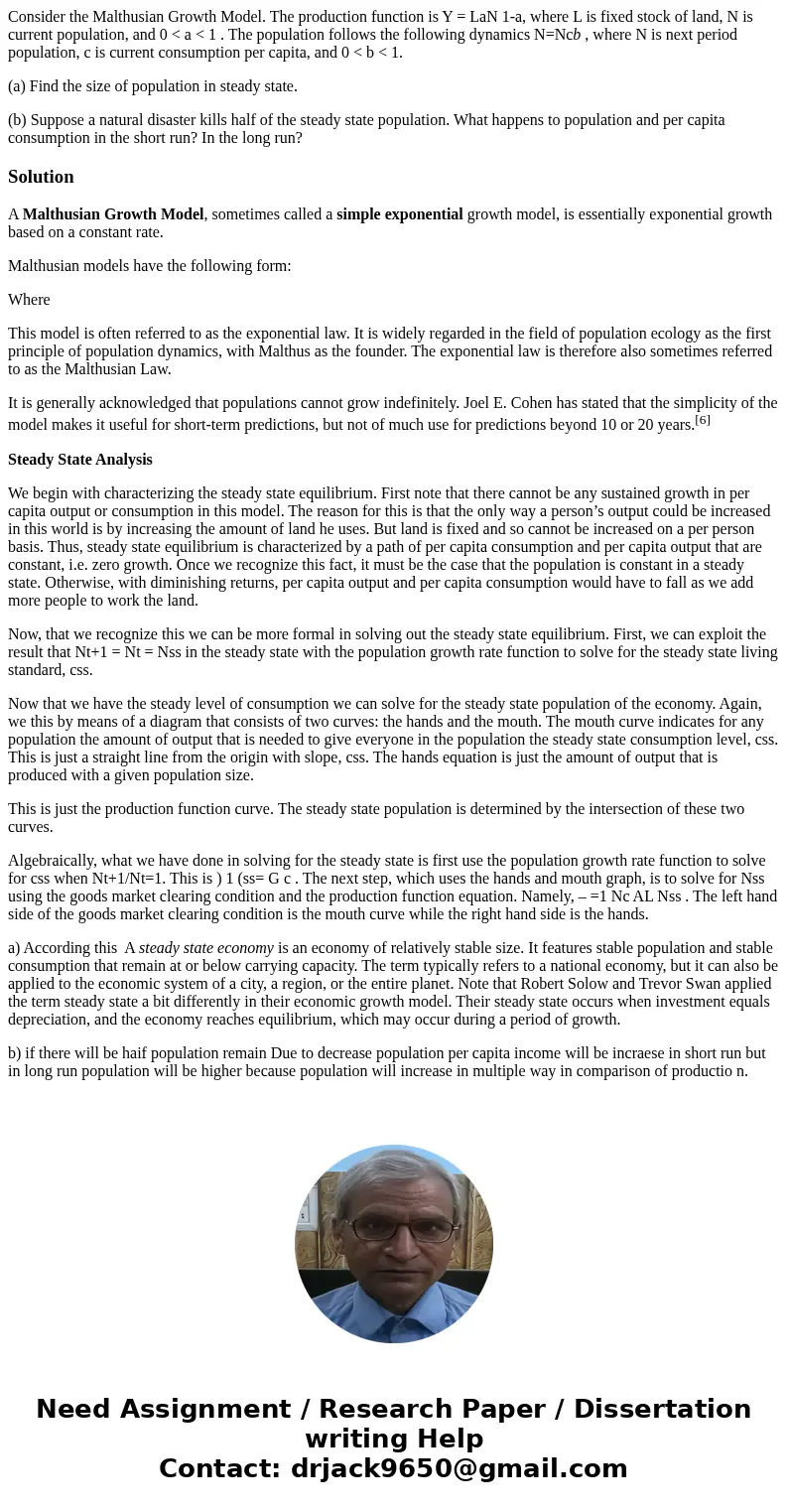Consider the Malthusian Growth Model The production function
Consider the Malthusian Growth Model. The production function is Y = LaN 1-a, where L is fixed stock of land, N is current population, and 0 < a < 1 . The population follows the following dynamics N=Ncb , where N is next period population, c is current consumption per capita, and 0 < b < 1.
(a) Find the size of population in steady state.
(b) Suppose a natural disaster kills half of the steady state population. What happens to population and per capita consumption in the short run? In the long run?
Solution
A Malthusian Growth Model, sometimes called a simple exponential growth model, is essentially exponential growth based on a constant rate.
Malthusian models have the following form:
Where
This model is often referred to as the exponential law. It is widely regarded in the field of population ecology as the first principle of population dynamics, with Malthus as the founder. The exponential law is therefore also sometimes referred to as the Malthusian Law.
It is generally acknowledged that populations cannot grow indefinitely. Joel E. Cohen has stated that the simplicity of the model makes it useful for short-term predictions, but not of much use for predictions beyond 10 or 20 years.[6]
Steady State Analysis
We begin with characterizing the steady state equilibrium. First note that there cannot be any sustained growth in per capita output or consumption in this model. The reason for this is that the only way a person’s output could be increased in this world is by increasing the amount of land he uses. But land is fixed and so cannot be increased on a per person basis. Thus, steady state equilibrium is characterized by a path of per capita consumption and per capita output that are constant, i.e. zero growth. Once we recognize this fact, it must be the case that the population is constant in a steady state. Otherwise, with diminishing returns, per capita output and per capita consumption would have to fall as we add more people to work the land.
Now, that we recognize this we can be more formal in solving out the steady state equilibrium. First, we can exploit the result that Nt+1 = Nt = Nss in the steady state with the population growth rate function to solve for the steady state living standard, css.
Now that we have the steady level of consumption we can solve for the steady state population of the economy. Again, we this by means of a diagram that consists of two curves: the hands and the mouth. The mouth curve indicates for any population the amount of output that is needed to give everyone in the population the steady state consumption level, css. This is just a straight line from the origin with slope, css. The hands equation is just the amount of output that is produced with a given population size.
This is just the production function curve. The steady state population is determined by the intersection of these two curves.
Algebraically, what we have done in solving for the steady state is first use the population growth rate function to solve for css when Nt+1/Nt=1. This is ) 1 (ss= G c . The next step, which uses the hands and mouth graph, is to solve for Nss using the goods market clearing condition and the production function equation. Namely, – =1 Nc AL Nss . The left hand side of the goods market clearing condition is the mouth curve while the right hand side is the hands.
a) According this A steady state economy is an economy of relatively stable size. It features stable population and stable consumption that remain at or below carrying capacity. The term typically refers to a national economy, but it can also be applied to the economic system of a city, a region, or the entire planet. Note that Robert Solow and Trevor Swan applied the term steady state a bit differently in their economic growth model. Their steady state occurs when investment equals depreciation, and the economy reaches equilibrium, which may occur during a period of growth.
b) if there will be haif population remain Due to decrease population per capita income will be incraese in short run but in long run population will be higher because population will increase in multiple way in comparison of productio n.

 Homework Sourse
Homework Sourse